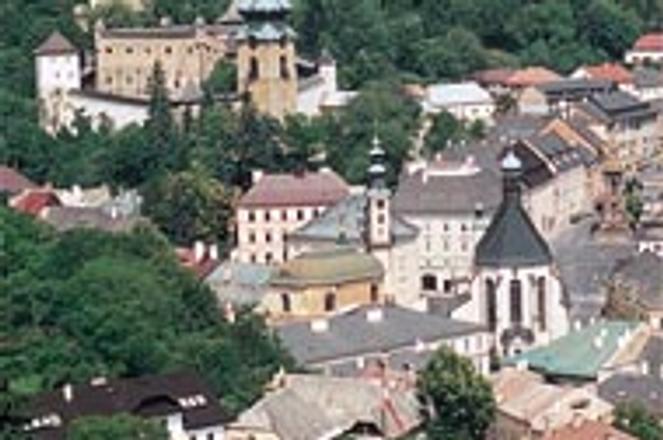Banská Štiavnica found its luck on the backs of salamanders, earned its fortune on the back-breaking labor of miners, and is now trying to regain its glory through tourism by piggy-backing its UNESCO status.Rick Zedník
Legend has it that it was a poor shepherd who first discovered silver in the hills of Banská Štiavnica. As his cattle were grazing, he saw a glittering movement among the rocks. Realizing it was a pair of salamanders with fine silver powder on their backs, the shepherd turned over the stone where the lizards disappeared and found a silver seam in the earth. Not long thereafter, the town became a leading mining center for all of Europe and the salamanders became the town's symbol.
The little legendary lizards inspired a tradition in Banská Štiavnica, where every autumn visitors can see miners, gold-guarding dwarfs, Nácko the fool of folklore, and Anča, the old steam locomotive that once ran from here to Zvolen, weaving through the streets in an annual parade known as "Salamander."
It might have been as long ago as 1156 when the first written document from the area was found, but the hills surrounding the town were probably inhabited much sooner. The document describes the region in Latin as "terra banensium" - miners' ground.
During mining's greatest boom in the middle of the 18th century, Banská Štiavnica's mines produced up to 24,000 kg of silver and 600 kg of gold per year. Mining activity was so fervent that the Mining Academy, the world's first technical university devoted to chemistry, physics and mineralogy, was established here in 1762.
The beginning of this century, however, brought tough times to Banská Štiavnica, as the mines were exploited and production was no longer profitable.
Today, Banská Štiavnica's mining tradition can be traced through the Mining Museum's exhibit of mining tools and machines. As a visitor, you also have the opportunity to go underground, helmet strapped to your head, to see a mine close-up.
UNESCO to the rescue
Sagging from an industry that had given all it had, Banská Štiavnica was resuscitated by the United Nations Educational, Scientific, and Cultural Organization (UNESCO).
"1993 is a watershed year in the town's history, when Banská Štiavnica was added to UNESCO's list of cultural and natural heritage," recollected Ján Novák, the town's deputy mayor. "The artificial water reservoirs and canals called 'tajchy' that once provided energy to operate the mining machines, became one of the world's heritage works included on UNESCO's list. Today, only a third of the 60 that once served the area still exist. Now, the tajchy make great centers for relaxing in Banská Štiavnica's beautiful natural surroundings."
Among Banská Štiavnica's treasures is its architecture. Every building breathes its own history and most of them are former residences of Slovakia's most famous writers, poets and scientists.
But the town's budget is insufficient to reconstruct even the most precious historical buildings in the town's center. Despite this, the cultural ambience is slowly being revived, and the town is becoming more and more attractive for tourists and entrepreneurs.
An example is The Grand, Banská Štiavnica's oldest hotel, closed for a couple of years, but which reopened this summer after extensive reconstruction. Viliam Klüovanský, the hotel's director, believes prospects are bright for business. "The town and its surroundings offer a variety of destinations for trips and sightseeing," he said. "Not only Slovaks, but a large number of foreign tourists come to see Banská Štiavnica's jewels every year. Since the hotel opened, we have been filled to at least 70 percent of capacity."
In Klüovanský's and others' minds, Banská Štiavnica can once again begin digging for a different brand of silver and gold.
S&S Travel tips
GETTING THERE
From Bratislava by train only at 6:03 and change in Hronská Dúbrava.
From Bratislava by bus at 7:05 to Žiar nad Hronom and change for Banská Štiavnica. Direct buses leave at 10:50, 13:00, and 16:20.
From Košice by train at 5:54, 10:20, or 14:40 and change in Hronská Dúbrava.
IMPORTANT PLACES
Nový Zámok (New Castle)- tel.: 0859/215-44, Mon-Sun 8:00 - 16:00. This three-storey fortress symbolizes the 16th century resistance against the Turks.
Starý Zámok (Old Castle)- tel.: 0859/231-13. The old castle in the town center is still being reconstructed but some parts can be visited.
Banská múzeum v prírode, skanzen (Open-air Mining Museum)- tel.: 0859/229-71. Mon-Sun 8:00-16:00. Two kilometres from the town, check out the collection of mining tools and machines and take the underground mine tour.
Slovenská banícke múzeum a Mineralogická múzeum (Slovak Mining and Mineralogy Museums)- Námestie sv. Trojice 47. tel.: 0859/225-47 Mon-Sun 8:00 - 16:00. Full of stones, rocks and crystals.
Morový stíp (Plague Column)- Nám. Sv. Trojice. Banská Štiavnica's famous monument.
Klopačka- Sládkovičova 18, tel.: 0859/237-65. Originally the Brothers Miners Treasury seat, and later a miners' prison, today it houses an exhibit on the development of Slovak mining.
Kalvária- This hilltop double-towered building guarded against the Turks and was later rebuilt for sacral purposes. It offers a stunning view of Banská Štiavnica and surroundings.
Tajchy- These 18th century reservoirs that used to help power mining machines, make for beautiful relaxation spots all around the town today.
LODGING
Hotel Grand***- Kammerhofská 5, tel.: 0859/621-294. 450 to 800 Sk per room.
Hotel Salamander***- Palárikova 1, tel.: 0859/239-92. A splendid hotel with first rate service and adjoining restaurant, café, and wine tavern. 600 to 900 Sk per room, breakfast for 50 Sk.
Pension U Mateja- Akademická 4, tel.: 0859/239-60. A nice little place with good service. 250 to 450 Sk per room.
Pension Kami- Kammerhofská 20, tel.: 0859/218-50. A friendly family atmosphere with only 10 beds. 100 Sk per person.
Pension Pri Klopačke- Novozámocká 16, tel.: 0859/219-45. Also 10 beds in a family atmosphere. 375 to 500 Sk per room.
DINING
Salamander- Palárikova 1, tel.: 0859/239-92. Mon-Sun 10:00 - 22:00.
Grand- Kammerhofská 5, tel.: 0859/237-82.
Hubert- Strieborná. Mon-Sun 10:00 - 23:00.
Gallery Restaurant- Námestie Sv. Trojice. Mon-Sun 9:00 - 22:00.
Author: Alexandra Tomová

